
Pope Gregory XIII, born Ugo Boncompagni, was head of the Catholic Church and ruler of the Papal States from 13 May 1572 to his death in 1585. He is best known for commissioning and being the namesake for the Gregorian calendar, which remains the internationally accepted civil calendar to this day.

The Counter-Reformation, also called the Catholic Reformation or the Catholic Revival, was the period of Catholic resurgence that was initiated in response to the Protestant Reformation. It began with the Council of Trent (1545–1563) and largely ended with the conclusion of the European wars of religion in 1648. Initiated to address the effects of the Protestant Reformation, the Counter-Reformation was a comprehensive effort composed of apologetic and polemical documents and ecclesiastical configuration as decreed by the Council of Trent. The last of these included the efforts of Imperial Diets of the Holy Roman Empire, exiling/forcibly converting Protestant populations, heresy trials and the Inquisition, anti-corruption efforts, spiritual movements, and the founding of new religious orders. Such policies had long-lasting effects in European history with exiles of Protestants continuing until the 1781 Patent of Toleration, although smaller expulsions took place in the 19th century.

Saint Sebastian was an early Christian saint and martyr. According to traditional belief, he was killed during the Roman emperor Diocletian's persecution of Christians. He was initially tied to a post or tree and shot with arrows, though this did not kill him. He was, according to tradition, rescued and healed by Saint Irene of Rome, which became a popular subject in 17th-century painting. In all versions of the story, shortly after his recovery he went to Diocletian to warn him about his sins, and as a result was clubbed to death. He is venerated in the Roman Catholic Church and the Orthodox Church.

Charles Borromeo was the Archbishop of Milan from 1564 to 1584 and a cardinal of the Catholic Church. He was a leading figure of the Counter-Reformation combat against the Protestant Reformation together with Ignatius of Loyola and Philip Neri. In that role he was responsible for significant reforms in the Catholic Church, including the founding of seminaries for the education of priests. He is honored as a saint by the Catholic Church, with a feast day on November 4.

The Quadroni of St. Charles are two cycles of paintings depicting the life and miracles of St. Charles Borromeo, the first Saint of the Counter-Reformation. These very large paintings (quadroni), approximately five by six metres each, are displayed each November in the Milan Cathedral in honor of St. Charles' name day on November 4. They were also exhibited continuously from November 4, 1999 to November 4, 2000 in honor of the Catholic Jubilee celebrations.
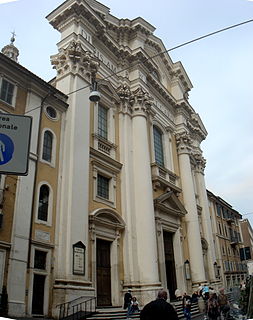
Sant'Ambrogio e Carlo al Corso is a basilica church in Rome, Italy, facing onto the central part of the Via del Corso. The apse of the church faces across the street, the Mausoleum of Augustus on Via di Ripetta.
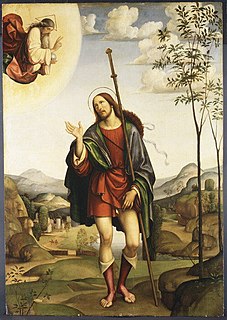
Roch or Rocco (lived c. 1348 – 15/16 August 1376/79 is a Catholic saint, a confessor whose death is commemorated on 16 August and 9 September in Italy; he is especially invoked against the plague. He may also be called Rock in English, and has the designation of Rollox in Glasgow, Scotland, said to be a corruption of Roch's Loch, which referred to a small loch once near a chapel dedicated to Roch in 1506.

Marian columns are religious monuments depicting Virgin Mary on the top, often built in thanksgiving for the ending of a plague or for some other reason. The purpose of the Holy Trinity columns was usually simply to celebrate the church and the faith, though the plague motif could sometimes play its role in their erection as well. Erecting religious monuments in the form of a column surmounted by a figure or a Christian symbol was a gesture of public faith that flourished in the Catholic countries of Europe especially in the 17th and 18th centuries. Thus they became one of the most visible features of Baroque architecture. This usage also influenced some Eastern Orthodox Baroque architecture.

San Carlo ai Catinari, also called Santi Biagio e Carlo ai Catinari is an early-Baroque style church in Rome, Italy. It is located on Piazza Benedetto Cairoli, 117 just off the corner of Via Arenula and Via dei Falegnami, a few blocks south of the church of Sant'Andrea della Valle.

The aristocratic Borromeo family were merchants in San Miniato around 1300 and became bankers in Milan after 1370. Vitaliano de' Vitaliani, who acquired the name of Borromeo from his uncle Giovanni, became the count of Arona in 1445. His descendants played important roles in the politics of the Duchy of Milan and as cardinals in the Catholic Reformation. In 1916 the head of the family was granted the title Prince of Angera by the King of Italy.

Santa Maria dei Monti is a cardinalatial titular church, located at 41 Via della Madonna dei Monti, at the intersection with Via dei Serpenti, in the rione Monti of Rome, Italy. The church is dedicated to the Blessed Virgin Mary.

The Protestant Reformation during the 16th century in Europe almost entirely rejected the existing tradition of Catholic art, and very often destroyed as much of it as it could reach. A new artistic tradition developed, producing far smaller quantities of art that followed Protestant agendas and diverged drastically from the southern European tradition and the humanist art produced during the High Renaissance. The Lutheran churches, as they developed, accepted a limited role for larger works of art in churches, and also encouraged prints and book illustrations. Calvinists remained steadfastly opposed to art in churches, and suspicious of small printed images of religious subjects, though generally fully accepting secular images in their homes.

Pompeo Ghitti was an Italian painter of the Baroque period, active mainly in and in towns surrounding Brescia.

The Chiesa della Santissima Trinità dei Pellegrini is a Roman Catholic church located on Via dei Pettinari #36 In the rione of Regola of central Rome, Italy. It stands a block away from the Palazzo Spada on Via Capo di Ferro, while a few blocks away on the Via dei Pettinari stands the Ponte Sisto.

Volterra Cathedral is a Roman Catholic cathedral in Volterra, Italy, dedicated to the Assumption of the Virgin Mary. It is the seat of the bishop of Volterra.
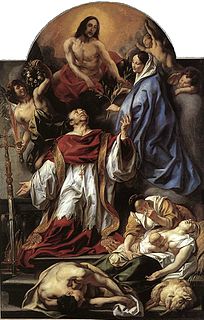
There are three plague crosses in Brugherio, in the province of Monza and Brianza in Lombardy, in northern Italy. They were erected after the plague that struck Monza and its surrounding area in 1576. The crosses are three that remain of four that marked where there were four altars used to celebrate religious services during the plague. The plague of 1576 was in fact called "the plague of Saint Charles", given the Bishop's closeness to those affected. Information about the plague can be found in the Bishop of Milan, Saint Charles Borromeo's notes.
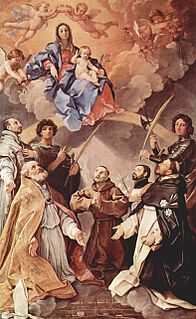
The Pala della Peste or Pallione del Voto is a Baroque-style altarpiece by Guido Reni depicts the Madonna and Child in Glory with the Patron Saints of Bologna: Petronius, Francis, Ignatius, Francis Xavier, Proculus of Bologna, and Florian. The painting is oil on silk.

Macerata Cathedral is a Renaissance-style, Roman Catholic cathedral dedicated to the St Julian in the town of Macerata, province of Macerata, region of Marche, Italy.
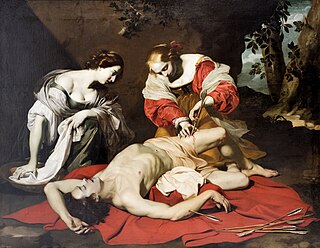
Saint Sebastian Tended by Saint Irene is an incident in the legends of Saint Sebastian and Saint Irene of Rome. It was not prominent in the hagiographical literature until the late Renaissance, and is hardly seen in art before then. As an artistic subject, normally in painting, it suddenly became popular from the 1610s, though found in predella scenes as early as the 15th century, and was most popular until about the 1670s.

The Miracles of St. Francis Xavier is a large altarpiece painted by Peter Paul Rubens in 1617 or 1618. It was originally commissioned by the Jesuits in Antwerp for their church, now known as the St. Charles Borromeo Church. It is now in the Kunsthistorisches Museum in Vienna. The painting depicts the miracles worked by St. Francis Xavier during his mission to Asia and includes a large variety of figures from Asia and Africa, as well as the destruction of a Hindu idol in the background. Rubens also painted a companion piece, The Miracles of St. Ignatius of Loyola.






















